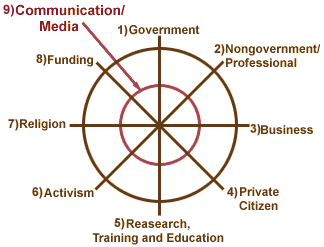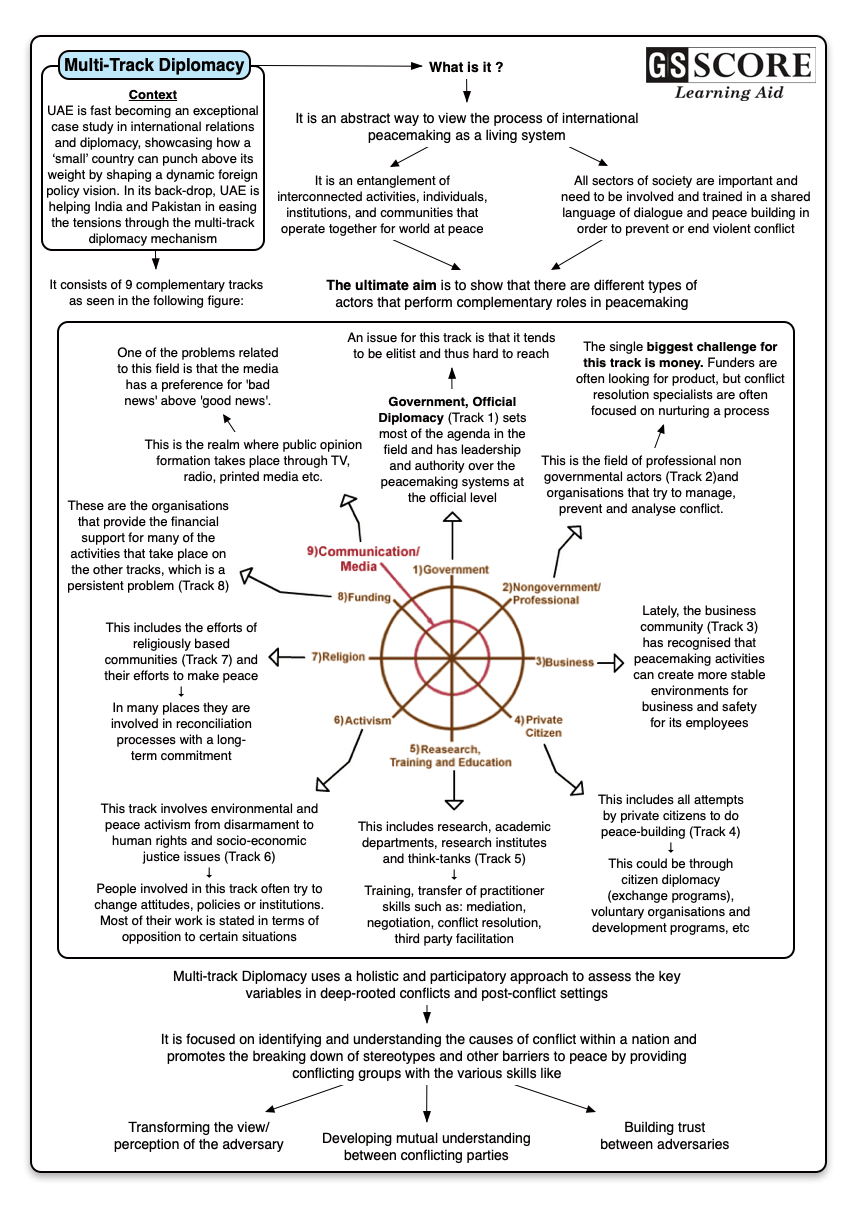

The UAE is fast becoming an exceptional case study in international relations and diplomacy, showcasing how a ‘small’ country can punch above its weight by shaping a dynamic foreign policy vision.
Issue
Context
The UAE is fast becoming an exceptional case study in international relations and diplomacy, showcasing how a ‘small’ country can punch above its weight by shaping a dynamic foreign policy vision. In its back-drop, UAE is helping India and Pakistan in easing the tensions through the multi-track diplomacy mechanism.
Background
- Multi-track diplomacy is an abstract way to view the process of international peacemaking as a living system.
- In multi-track diplomacy, all sectors of society are important and need to be involved, supported, listened to, and trained in a shared language of dialogue, conflict resolution, and peace building in order to prevent or end violent conflict. It is an entanglement of interconnected activities, individuals, institutions, and communities that operate together for world at peace.
- Aim: To show that there are different types of actors that perform complementary roles in peacemaking.
Analysis
Why Multi-Track Diplomacy is needed?
- In the last decade, the international community has been faced with more guerrilla warfare, attempts at secession and other types of intra-state violence. The traditional practices of diplomacy (formal meetings between official representatives of states) are ill-equipped to deal with these challenges.
- The tension between India and Pakistan can be eased by employing multi-track diplomacy. Oslo agreement is the product of multi-track diplomacy.m
Structure of Multi-Track Diplomacy
- Multi-Track Diplomacy consists of nine complementary 'tracks'. These are:
- governments
- professional organisations
- the business community
- private citizens
- training, research and educational institutions
- activists
- church organisations
- funding
- media
Nine Tracks of Multi-Track Diplomacy

Track One: Government, Official Diplomacy
- Track One sets most of the agenda in the field and has leadership and authority over the peacemaking systems at the official level. Most political peace-building (the making of political agreements, decisions regarding use of force) is done by this track.
- An issue for this track is that it tends to be elitist and thus hard to reach. It often shuts itself out from expertise and alternative voices in the field, such as NGOs, specialist groups, identity groups, formal and informal citizen groups. It is male dominated. Track One negotiators should be more prepared for dealing with this through multi-lateral negotiation skills training.
- Examples of Track One organisations: States, official diplomats, the military, government-run development programs (Governmental Organisations), Inter-governmental organisations such as the UN, UNESCO, NATO, the EU, the OSCE, the WEU, The World Bank, The IMF, the FAO
Track Two: Nongovernmental/Professional and Peacemaking through Conflict Resolution.
- This is the field of professional non-governmental actors and organisations that try to manage, prevent and analyse conflict. They come from vastly different backgrounds. Individuals and organisations in this track do mediation, consulting, problem-solving workshops, conferences etc.
- The single biggest challenge for this track is money. Funders are often looking for product, but conflict resolution specialists are often focused on nurturing a process. Examples are: Search for Common Ground (Conflict Resolution), The Institute for Multi-Track Diplomacy, Pax Christi, Life and Peace Institute.
- Other professional organisations without a clear conflict resolution agenda are also included in this track like: Doctors Without Borders (MSF), the Red Cross, Oxfam, Novib and other Development Organisations.
Track Three: Business, or Peacemaking trough Commerce
- This is the business world with its potential for peace-building through commerce. The traditional business community is profit-oriented, competitive and conservative. But lately the business community has recognised that peacemaking activities can create more stable environments for business and safety for its employees.
- Issues for the business community often include environmental responsibility and social responsibility for the countries in which it operates: How to balance profitability with responsibility.
Track Four: Private Citizens or Peacemaking through personal involvement
- This includes all attempts by private citizens to do peace-building. This could be through citizen diplomacy (exchange programs), voluntary organisations and development programs, advocacy or special interests groups, professional interest groups and democracy-building organisations.
- This track often includes a wide range of NGOs, local and international. These individuals have a tremendous amount of knowledge of what happens on the ground, although they often have difficulty finding connections with the rest of the peacebuilding system.
Track Five: Research, Training, and Education or Peacemaking trough Learning
- This includes research,
- academic departments, research institutes and think-tanks
- Training, transfer of practitioner skills such as: mediation, negotiation, conflict resolution, third party facilitation
- Education, from kindergarten to Ph.D. programs
- One of the issues of this track is how to produce and transfer relevant information for practical use in conflicts.
Track Six: Activism, or Peacemaking through Advocacy
- This track involves environmental and peace activism from disarmament to human rights and socio-economic justice issues. People involved in this track often try to change attitudes, policies or institutions. Most of their work is stated in terms of opposition to certain situations.
- Often organisations in Track Six are one topic oriented, like Amnesty Internationaland Human Rights Watch in regards to Justice and Human Rights.
- An argument could be made for placing Amnesty International under track 2 as well. These organisations engage in a whole range of activities: education, advocacy, organising, supporting, witnessing and protesting.
- Issues for this track include small NGOs relative lack of power, their reputation as 'peaceniks' and way of often defining themselves as 'anti' this or that, as opposed to constructive involvement.
Track Seven: Religion, or Peacemaking through Faith in Action.
- This includes the efforts of religiously based communities and their efforts to make peace, from small church groups to larger religious communities of different denominations.
- In many places they are involved in reconciliation processes with a long-term commitment and thus are very well placed as contacts and confidants of conflicting parties.
Track Eight: Funding or Peacemaking through Providing Resources.
- These are the organisations that provide the financial support for many of the activities that take place on the other tracks, which is a persistent problem.
- Many funding organisations look for measurable results within a limited amount of time (typical funding cycles are 2-3 years), which can be too little time in many peace-building processes.
Track Nine: Communication and the Media, or Peacemaking through Information
- This is the realm where public opinion formation takes place through TV, radio, printed media etc. This track informs the public and engages it in issues of conflict and peace.
- One of the problems related to this field is that the media has a preference for 'bad news' above 'good news'. A successful attempt at preventing an outbreak of conflict, for example the preventive diplomacy between India and Pakistan over Kashmir issue is often not considered 'news' and thus receive criticism in India.
|
Case-Study – Multi-Track Diplomacy
|
Conclusion
Multi-track Diplomacy uses a holistic and participatory approach to assess the key variables in deep-rooted conflicts and post-conflict settings. It is focused on identifying and understanding the causes of conflict within a nation. It promotes the breaking down of stereotypes and other barriers to peace by providing conflicting groups with the following skills:
- Transforming the view/perception of the adversary
- Developing mutual understanding between conflicting parties
- Building trust between adversaries
- Reconciling past grievances
- Negotiation
- Creating cultural awareness
Learning Aid



